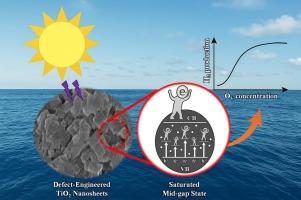优化TiO2纳米片的低温缺陷工程,增强光催化水分解
IF 6.9
2区 材料科学
Q2 CHEMISTRY, PHYSICAL
引用次数: 0
摘要
在含h2气氛下的热处理被广泛用于在TiO2表面和内部引入氧空位(OV)。然而,关键工艺参数(特别是气体流速和暴露时间)的影响仍未得到充分研究。在这项工作中,我们全面研究了TiO2纳米片(TiNSs)在200 °C下,在不同的Ar/H2流速(10-200 mL/min)和持续时间(0.5-4 h)下,通过控制热还原的缺陷工程。结构,电子,化学状态和光催化表征-包括BET, XRD, UV-Vis, EPR, XPS和电化学测量-揭示了处理条件,缺陷浓度和光催化性能之间的强相关性。在50 mL/min Ar/H2条件下处理1 h的TiNSs中Ti3+含量最高,epr测定的自旋浓度为2.21 × 1017个自旋/摩尔,显著降低了电荷转移阻力。优化后的样品H2的析出速率为376.2 µL h−1 g−1,约为未处理的tins的8倍。DFT计算表明,优化后的样品极有可能呈现饱和中隙状态。总之,这些结果揭示了还原气氛动力学在微调TiO2缺陷景观中的关键作用,为合理设计下一代绿色制氢光催化剂铺平了道路。本文章由计算机程序翻译,如有差异,请以英文原文为准。

Optimizing low-temperature defect engineering in TiO2 nanosheets for enhanced photocatalytic water splitting
Thermal treatment in H2-bearing atmospheres is widely used to introduce oxygen vacancies (OV) both on the surface and within the bulk of TiO2. However, the influence of key processing parameters—particularly gas flow rate and exposure time—remains underexplored. In this work, we present a comprehensive study on the defect engineering of TiO2 nanosheets (TiNSs) via controlled thermal reduction at 200 °C under varying Ar/H2 flow rates (10–200 mL/min) and durations (0.5–4 h). Structural, electronic, chemical state, and photocatalytic characterizations—including BET, XRD, UV–Vis, EPR, XPS, and electrochemical measurements—reveal a strong correlation between treatment conditions, defect concentration, and photocatalytic performance. TiNSs treated at 50 mL/min Ar/H2 for 1 h exhibited the highest Ti3+ content, with an EPR-determined spin concentration of 2.21 × 1017 spins/mole, significantly reducing charge transfer resistance. This optimized sample achieved an H2 evolution rate of 376.2 µL h−1 g−1, approximately 8 times higher than untreated TiNSs. DFT calculations indicate that the optimized sample most likely exhibits saturated mid-gap states. Together, these results shed new light on the critical role of reduction atmosphere dynamics in fine-tuning TiO2′s defect landscape, paving the way toward the rational design of next-generation photocatalysts for green hydrogen production.
求助全文
通过发布文献求助,成功后即可免费获取论文全文。
去求助
来源期刊

Applied Surface Science
工程技术-材料科学:膜
CiteScore
12.50
自引率
7.50%
发文量
3393
审稿时长
67 days
期刊介绍:
Applied Surface Science covers topics contributing to a better understanding of surfaces, interfaces, nanostructures and their applications. The journal is concerned with scientific research on the atomic and molecular level of material properties determined with specific surface analytical techniques and/or computational methods, as well as the processing of such structures.
 求助内容:
求助内容: 应助结果提醒方式:
应助结果提醒方式:


